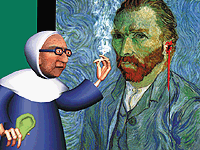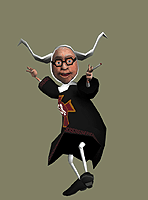Using proprietary motion-capture software and creative partnerships, Protozoas DotComix is quickly becoming a force on the Internet. Lee Dannacher offers an inside peak.

Borne out of the innovative talents of 3D animation company Protozoa, DotComix is fast becoming a stylish and diverse production-destination voice on the Web. Using performance animation as its cornerstone, dotcomix.com is a whirlpool of contemporary animated content with approximately 14 episodic titles now online. These zany, irreverent cartoons all showcase the Web potential for deep, rich real-time programming. By successfully marrying a passel of characters with their award-winning motion-capture software Alive!, DotComix can boast of bringing new animated series to life faster and at a lower cost than anyone else on todays Internet domains.
Launched in March of 1999 from their headquarters in San Francisco, the entertainment companys array of online shows is an eclectic mix of original fare alongside animated productions based on comic books and radio series. Targeting the early adopter Internet crowd of 18-34 year olds, the sites comedy writing is satirical and cheeky -- with the added attraction of being able to offer dead-on topical stories drawn from headline news, made possible by the incredibly fast turnaround of their unique production process.

Dotting the Net
Two of the site's most popular titles are Gates Of Hell, a madcap parody starring the beleaguered Microsoft chairman, and Virtual Bill, another real-life celebrity lampoon featuring a digitized President Clinton. Initially created in 1998 for MTV on-air broadcasts, Virtual Bill has been the first major property to underscore the creatively successful and technically seamless transference of a DotComix show between the broadcast and Internet mediums. Although photo-realistic humans are very hard to achieve in CGI, especially when animating recognizable figures, DotComix did their homework with these two properties by first clocking the real-life characters' expressions and mannerisms, carefully casting both the motion and voice actors, then skillfully animating them within their special blend of motion sensor and computer artistry.
Other current Net productions include: the original series Sister Randy, an uproarious course in art history conducted by a cigarette-puffing nun (having gained immense popularity, the series was just recently licensed by BBC America). Mr. Cranky, a disembodied face and hands spouting angry yet timely reviews on the latest video releases (the series motto being: "He never met a movie he didnt loathe!")The Dr. Science series, based on the long-running NPR program, is currently airing on entertaindom.com, along with the original DotComix series Floops. and Tom Tomorrow, This Modern World which utilizes a flat, cut-out style of animation that is, nonetheless, also produced with a motion-capture underpinning to achieve a quicker production schedule. For community play, the site offers up a SPAM-O-GRAM section which gives the viewer a revolving selection of toon favorites that can be personalized with messages, then forwarded swiftly through e-mails around the online world.

DUKE 2000 An Animated Quest for the White House
A major company effort (and source of great fun) surrounds DotComix' newest collaboration with Gary Trudeau on the production of the Duke2000 Presidential campaign. The company first worked with Trudeau on a 3D animated rock video, which was webcast during NetAid's live international event to fight hunger on October 9th of last year.
The on-going Duke2000 campaign, unquestionably the first transmedia event of its kind, entails the fictional Ambassador Duke running for President in the real world. Animated and produced by DotComix, written by Trudeau and a team of writers working together with the dotcomix staff, Duke has been appearing in multiple media locales since his candidacy was announced earlier this year. Venues include: online (with new content going up each week at dotcomix and the Excite sponsored duke2000.com), on television (a one hour Larry King Live interview featured the animated Duke interacting in real-time with celebrities Al Franken and Bill Maher, with a number of other TV appearances coming up soon); on radio (a 30 city drive-time interview tour was just completed last month); and in print media (including Duke's regular visits to Trudeau's Doonesbury strip, and published interviews such as the one in the May issue of George magazine). As the company describes it: "With Duke's subversive campaign, the walls between the various media are crumbling."
It feels almost sacrilegious to describe the behind-the-scenes production of Duke in fear of busting his seemingly real persona. One technical footnote, though, is that this is the first DotComix production to use QuickTime as its Internet media player. It was vital to the reality of this series to integrate live action actors and backgrounds with the 3D created Duke, so the animation-only Pulse Entertainment Player -- the technology presently downloaded by the viewer to power all other DotComix shows -- wasn't suitable. Partnering with Apple has given DotComix the QuickTime technology necessary for those creative purposes, and additionally brings onboard Apple's infrastructure and servers to handle the huge amount of traffic amassing around the online campaign. The company will continue producing Duke2000's cross-platformed media all the way through inauguration and, only half-jokingly, they suggest that in the event Duke actually takes the Presidency, we'll have four more years with him!

Alchemy in the Company's Mix
Brad deGraf (CEO and Chairman) co-founded DotComix in early 1999 along with long time colleagues Eric Gregory (Chief Technology Officer) and Marc Scaparro (Head of Production). Together, the trio has a substantial history in leading performance and computer animation in new directions. DeGraf's pre-computer life included designing sculptural furniture and studying architecture at Princeton, which he later combined with a degree in Mathematics from the University of California at San Diego. After stints designing programs for the US Army National Training Center and as Head of Technical Direction at Digital Productions, he founded deGraf/Wahrman. The beginnings of his collaboration with Scaparro and Gregory took place in deGraf's basement where they co-authored the architecture of the proprietary software they named Alive! Taking it with them to Colossal Pictures, they formed that studio's in-house Digital Media Group, using their nascent technology in the creation of Cartoon Networks digital emcee "Moxy" (the first real-broadcast motion-capture character) and Peter Gabriel's Grammy Award-winning music video "Steam." In 1994, the three spun off to form Protozoa and jumped headlong into television production, software sales and the then-burgeoning market of 3D animated games. In late 1996, with the advent of the Internet's 3D player technology VRML (Virtual Reality Modeling Language), the group began producing their first online characters, designing the well-known Spider and Alliskator properties -- work that deGraf feels was "the first really non-video animation on the Web." Next came a series for SGI entitled Floops which, deGraf believes, "can really claim to be the first episodic cartoon on the Web."
The Internet soon became the trios primary focus and for their transformation into the DotComix of today, deGraf recruited Damon Danielson as President and CEO. Since January of 99, Danielsons talents have been directed toward building the team, modeling the relationships and marshalling the financing necessary to position the company as a leader in its new Internet space. The Yale educated Danielson has had a wealth of creative and business experience ranging from work with Sony New Technologies, b-to-b Internet company Music One and Silicon Entertainment where, as CEO/President, he rode herd over the diversified company engaged in highly interactive games and NASCAR themed simulators.
Executive Producer Buzz Hayes, with his extensive film production and new media background, was brought in to create, produce and assemble the cluster of original programming needed to make up DotComix new dot-com identity. With a Masters in Film Production from USC, Hayes first spent around 10 years as head of research and development at LucasFilms THX. He then started his own independent company, Stones Throw Films, where he produced the smash Indy film Swimming With Sharks starring Kevin Spacey. Next came his co-founding of Robert DeNiros Tribeca Interactive which created the critically successful CD Rom entitled "IX." This adventure games art design and irreverent tone attracted the attention of deGraf who later enlisted Hayes to incubate the DotComix world.
Jane White, having joined deGraf and company in 1996, was already in place and primed to continue her work as Sr. VP of Development and Executive Producer for DotComix new adventures. From the roots of the six people deGraf, Scaparro and Gregory had at the beginning, todays DotComix mix of talent modelers, animators, writers, producers and directors numbers around 35. That work-force is expected to double in the next four to six months as the floodgates for new production swing wider each day.

Mapping Future Motion
In discussing the future, DotComix is taking what Danielson calls the "sneaker approach" in syndicating their shows to outside partnerships while simultaneously building their body of work into a magnetic Web destination. He states, "All of the entertainment that you would find on our Web site, we would work with other distribution partners on the Web -- and now on television, as well -- to syndicate the properties and to generate revenue through doing that." In the process, he continues, "Those relationships, we think, will bring us traffic and keep our eyeball acquisition costs very low in terms of driving people back to our own site." DeGraf jokes that, "The whole issue of being a portal vs. syndication -- weve been too wimpy to choose!" But the reality is that they have a very savvy business plan in place. Having just completed a Series C financing round, they can now shoot forward with plans for a rapid expansion on both the companys production and business fronts.
Although creatively and financially satisfying, DotComix has backed off producing for-hire entertainment projects (such as last years highly regarded series The Dog & Dinosaur Show for BBC Choice and the creation of the successful "M&Ms" live Crispy character for its national media tour). The exception would be, Danielson notes, if "something so stupid and so good walks in the door that you just have to do itsomething that may be strategically relevant or we think its going to make a big splash in the marketplace." Otherwise, they are staying focused on their own intellectual properties while remaining open to joint productions involving equity and ownership positions.
With ambitious goals to reach a more diverse Internet audience, DotComix is prepping an agglomeration of community-targeted channels. Up first will be the launch of its broadband venue sometime this month. Bringing on name-brand directors, DotComix has developed a clever strategy of stringing their immense 3D library of productions together with original fare into a network-type format that will exhibit richer programming for the high bandwidth audience. Next to hit the Net will be a channel targeting the younger womans audience which is expected to be up within a couple of months. At the same time, PolkaDotcomix, a kids destination channel, is in significant development for an expected launch sometime next Fall.

Staying Alive!
Located in an old mayonnaise factory, DotComix has three motion-capture stages, a blue screen set-up, plus a portable performance animation stage for producing certain live events out-of-house. They are in the process now of retrofitting their space to accommodate the brisk expansion of programming and requisite creative personnel. Hayes is keen on ramping up to an even greater series output, confident in relying on the fast turnaround of DotComix' production style.
"The advantage to the speed within which we work is that if a show is not working, we can acknowledge that and go on to something else that does work or we can craft it to the point where were happy with it," he explains. "I think our model is we can do a whole series in the amount of time and effort it takes most people to do a pilot." From an audiences point of view, however, he believes strongly that its important to "not put technology in the forefront and just make entertaining cartoons -- however they get made." He goes on, "The important thing for us is that we get the chemistry going, get the writing to gel, get everything to work because thats what its all about, entertaining and good writing and character designs. Its not about pixels and digibytes."
What makes their Alive! system shine in the industry, Hayes advocates, is the fact that they can adapt their programming so readily to achieve simultaneous life-forms on the Web, television, cable and live events. "We're trying to do shows that filter out into all those areas but bring people back to the Web where they can catch up on the episodes they missed. Plus, they can find out more information about the shows and all that kind of stuff rather than try and force the Internet to somehow be a television station." He's also stimulated by the high-speed capabilities of producing with Alive!, "in terms of how we can make stories that are very reactive to what's going on in the news and in the worldand the flip side of that is that the fan base lets us know right away whether they like it. So it's a very nice feedback loop."

Capturing Transmedia Appeal
Danielson is enthusiastic about converting more of their original properties into transmedia action and strategizing their performance into solid and repeatable business models. He also refers to the Duke campaign as a powerful example of getting their shows "in multiple mediums that help to drive traffic back to the site and create a broader interest on a national level that you cant do as a micro-site on the Web." Adding to that, deGraf states, "The biggest challenge is spreading out -- producing more but without diluting it and actually, the other part that I am really excited about is going up a level in our production quality. Up until now its been fast-and-furious just to get as much up there as we can and now we feel like we have a large enough volume that we can be more selective. We can take longer writing our stuff and we can filter out shows that don't work as well so that the overall density of really funny stuff is much higher."

Widening The Reach
Danielson feels the international expansion of dot-com animation is definitely the next big opening. "There's so much going on right now in terms of the multi-channel world," he states. "We've already formed a great strategic relationship up in Canada with Rogers Communications and we see a lot of opportunity in Europe and in South America and Asia." DotComix shows are easily re-purposed into different languages and production of localized tracks is now in the center of on-going work. "When I sit here and think about what we could be doing in a couple of years in terms of how broad our reach could be," he muses, "it's very exciting."
deGraf is also highly motivated by the scope of todays Internet audience. "Were broadcasting worldwide right now, and our potential audience is about as big as The Cartoon Networks." He says, "We definitely want to go into more interactivity and more community based stuff. Weve now got the resources to actually get programming out to that audience so to me, what will be exciting is building it, getting well known, having people appreciate what we do, getting the feedback and making a real business out of it." He realizes the importance of garnering strong name recognition for themselves and believes that, "ultimately, it really comes down to voice and, you know, who we are and what we decide to produce, what the writing is. Its not so much that were better than anybody else, were just different. And I think thats where the real success will be -- the long-term success depends on having a good voice and telling stories that people want to hear."
This assorted mix of personalities whipping up a spectrum of distinctive transmedia fare will surely bring a future filled with entertaining productions at the proliferating DotComix dot-com.
Lee Dannacher is an animation producer/sound track director of over 300 half hours of television films, as well as numerous network and video holiday specials. Currently based in New York, she is freelancing in audio, project development and new media productions.







